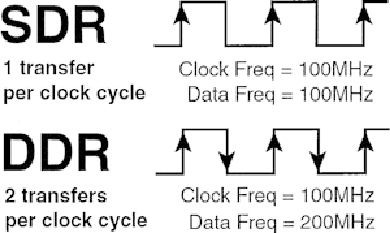Hardware Reference
In-Depth Information
Caution
In general, PC133 memory is considered to be backward compatible with PC100 memory.
However, some chipsets or motherboards had more specific requirements for specific types
of 100MHz or 133MHz chips and module designs. If you need to upgrade an older system
that requires PC100 memory, you should not purchase PC133 memory unless the memory is
specifically identified by the memory vendor as being compatible with the system. You can
use the online memory-configuration tools provided by most major memory vendors to en-
sure that you get the right memory for your system.
Typically, you find SDRAM modules rated CL 2 or CL 3.
DDR SDRAM
DDRSDRAMmemoryisaJEDECstandardthatisanevolutionaryupgradeinwhichdata
transfers twice as quickly as standard SDRAM. Instead of doubling the actual clock rate,
DDR memory achieves the doubling in performance by transferring twice per transfer
cycle: once at the leading (falling) edge and once at the trailing (rising) edge of the cycle
(see
Figure 6.2
)
. This effectively doubles the transfer rate, even though the same overall
clock and timing signals are used. To eliminate confusion with DDR, regular SDRAM is
often called
single data rate
(SDR).
Figure 6.2
SDR versus DDR cycling.
DDR SDRAM first came to market in the year 2000 and was initially used on high-end
graphics cards because there were no motherboard chipsets to support it at the time. DDR
finally became popular in 2002 with the advent of mainstream supporting motherboards
and chipsets. From 2002 through 2005, DDR was the most popular type of memory in
mainstream PCs. DDR SDRAM uses a DIMM module design with 184 pins.
Figure 6.6
(later in this chapter) shows the 184-pin DDR DIMM.
DDR DIMMs come in a variety of speed or throughput ratings and normally run on 2.5
volts.
Table 6.5
compares the types of industry-standard DDR SDRAM modules. As you



